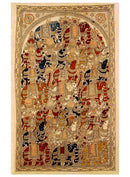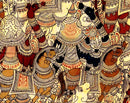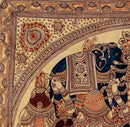The beautiful Kalamkari painting depicts some of the animals moving forward in a spirited manner. The elephants, the horses, the oxen, camel etc are painted in a nice manner and the painting has some beautiful carvings. The Kalamkari art of painting is one of the most celebrated forms of art in the country and undergoes a laborious, slow process of resist - dyeing and hand printing method. Basically a pen work, it involves many stages before the final results are achieved. Unlike other styles of painting, Kalamkari painting demands a lot of treatment before and after the painting is completed on the cotton fabric. Depending on the treatment of cloth, or quality of the mordant, the colours change accordingly. Every step from soaking of the cloth, to sketching the outlines to washing and drying the cloth, is done carefully and correctly. The harmless, naturally dyed fabrics is used for Kalamkari paintings. The artists believe in using natural dyes, extracted from bark, flower and root. One would be stunned to know that the colour red is obtained by using the Indian madder root, yellow from the pomegranate seed or even mango bark, and black from myrobalam fruit. No chemical dyes are used is producing kalamkari colours!
Description
The beautiful Kalamkari painting depicts some of the animals moving forward in a spirited manner. The elephants, the horses, the oxen, camel etc are painted in a nice manner and the painting has some beautiful carvings. The Kalamkari art of painting is one of the most celebrated forms of art in the country and undergoes a laborious, slow process of resist - dyeing and hand printing method. Basically a pen work, it involves many stages before the final results are achieved. Unlike other styles of painting, Kalamkari painting demands a lot of treatment before and after the painting is completed on the cotton fabric. Depending on the treatment of cloth, or quality of the mordant, the colours change accordingly. Every step from soaking of the cloth, to sketching the outlines to washing and drying the cloth, is done carefully and correctly. The harmless, naturally dyed fabrics is used for Kalamkari paintings. The artists believe in using natural dyes, extracted from bark, flower and root. One would be stunned to know that the colour red is obtained by using the Indian madder root, yellow from the pomegranate seed or even mango bark, and black from myrobalam fruit. No chemical dyes are used is producing kalamkari colours!
Payment & Security
Your payment information is processed securely. We do not store credit card details nor have access to your credit card information.






